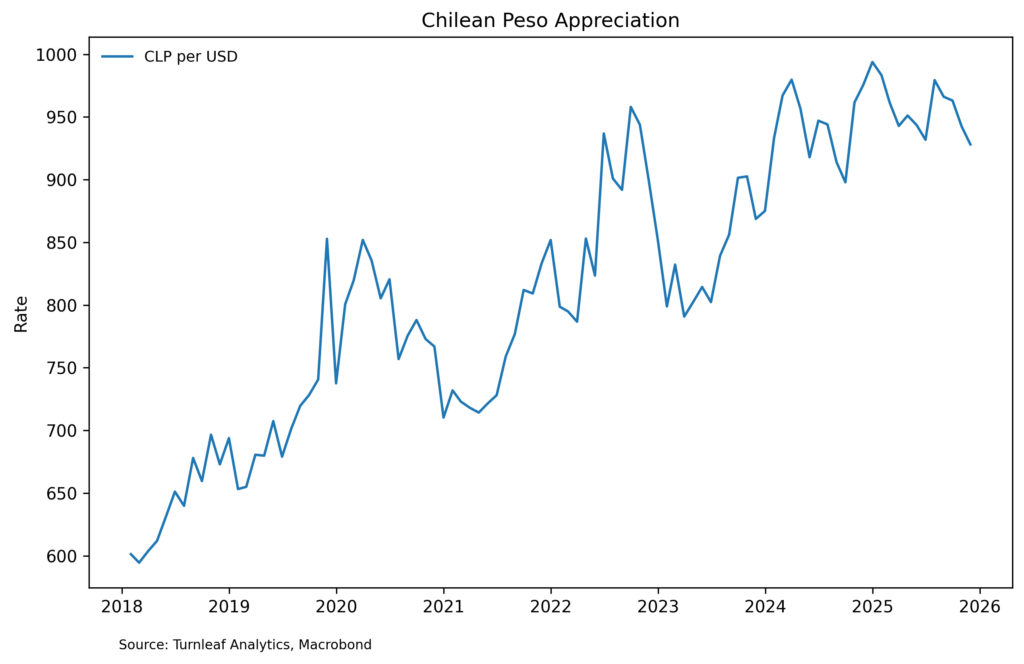Featured Research
Macroeconomic Insights: Chile CPI – It’s Not All That Bad
Turnleaf expects Chilean inflation to ease below the central bank's 3% target in early 2025, driven by peso appreciation compressing import prices and subdued energy costs (Figure 1 - PAID). Despite elevated copper prices sustaining terms of trade, export volume...
Macroeconomic Insights: Chile CPI – It’s Not All That Bad
Turnleaf expects Chilean inflation to ease below the central bank’s 3% target in early 2025, driven by peso appreciation compressing import prices and subdued energy costs (Figure 1 – PAID). Despite elevated copper prices sustaining terms of trade, export volume constraints have kept revenue growth muted.Energy Disinflation Driven by Currency Strength
Chilean energy prices have decelerated notably in recent months, driven primarily by peso appreciation, which has reduced the local-currency cost of dollar-priced energy inputs, and lower global oil prices. As the CLP strengthened by roughly 8% against the USD since mid-2024, dollar-denominated electricity contracts translated into lower peso costs, offsetting underlying operational pressures (Figure 2)
Figure 2

However, retail fuel prices exhibit persistent stickiness relative to international crude benchmarks. Turnleaf’s proprietary Fuel Price Index for Chile indicates recent plateauing in benzine price growth (Figure 3), consistent with elevated retail margins stemming from oligopolistic downstream market structure and distribution constraints. This partial offset limits the full disinflationary impulse from lower Brent crude, though the net effect remains disinflationary.
Figure 3
 Upward Cost Pressures Persist in Mining Sector
Upward Cost Pressures Persist in Mining Sector
Chile’s mining sector faces persistent cost escalation despite supportive copper price dynamics (Figure 4). Producer price inflation for mining has accelerated in recent months, driven by elevated energy and labor inputs alongside structural headwinds from declining ore grades at mature operations.
To read the rest, visit Turnleaf’s latest Substack post, here.
Research Archive
Gelato and accurate data in markets
I've been subscribing to the FT for many years. Primarily, I read it to keep track of financial markets. FT's longer form pieces complement having access to short articles on...
Macroeconomic Insights: Peru CPI – Seasonality Overshooting Inflation Forecasts
Since May 2025, Peru’s inflation has been consistently undershooting the forecasts of the central bank and economists. Figure 1 shows successive BCRP forecast vintages for...
Macroeconomic Insights: Philippines CPI – Fish Takes a Bite Into Inflation
For the past few months, we have seen our forecasts for the Philippines adjust upwards as the central bank pivots from inflation-defensive to disinflation-offensive. Our...
Macroeconomic Insights: Colombia CPI — Understanding Prices Through the Media
In Colombia, almost 17% of the consumer price basket are administratively set. This includes household public services, transport, fuel, and education fees. The legislation...
Macroeconomic Insights: Energy Prices —The Arbiter of Czech Republic CPI
Turnleaf expects Czech CPI to fall close to 2% YoY by the end of 2025 and then float back up towards 3% YoY through 2026. In the short term, our model places greater weight on...
Macroeconomic Insights: What’s on the Inflation Menu? – Turnleaf’s Food Index Catalogue
In Spain, it’s jamón. In Italy, Parmigiano Reggiano. In Japan, fresh fish. Every country has its culinary treasures, but when the prices of these beloved staples rise, the...
Macroeconomic Insights: Italy and Spain CPI: Unpacking Energy
Understanding how energy costs feed into CPI is crucial for accurately interpreting headline inflation in Europe. Both Spain and Italy offer unique case studies of how specific...
Macroeconomic Insights: South Africa CPI – Inflation and the Rand
Currently, the SARB has revised its forecasts downwards in response to rand appreciation and weaker economic growth. In contrast, Turnleaf’s model paints a more optimistic...
Macroeconomic Insights: Romania CPI Runs Hot
The recent surprise increase in electricity prices in Romania has pushed inflation close to 8%YoY. As Romania begins to rollback inflation fighting policies in the next couple of...
Macroeconomic Insights: U.S. CPI, Evaluating the Impact of Tariffs at Home and Abroad
When evaluating the impact of tariffs on consumer prices, we consider how they affect prices both domestically and abroad. Key factors include the effective tariff rate, the...
Macroeconomic Insights: Switzerland CPI – Just How Much Will Tariffs Hurt Switzerland?
Last week, President Trump threatened to impose a 39% tariff on Switzerland, higher than the initial 31% discussed in April 2025. With the U.S. being a major importer of Swiss...
Macroeconomic Insights: Eurozone CPI – Inflation Running Hotter Than Expected
The Eurozone Grew More Than Expected – Germany & Italy Overall, the Eurozone has enjoyed 0.6%QoQ growth in 2025Q1 despite disinflationary forces like weaker consumer and...
Macroeconomic Insights: Israel CPI – Air Travel Expected to Bump Up August Print
On August 3, 2025, Ben Gurion Airport will resume over 120 international flights for the month, though this remains insufficient to fully meet demand. Israeli travel companies...
Macroeconomics Insights: Europeans Can Finally Buy An Apocalypse Hellfire at 0% Tariff
Recently Trump announced a trade deal with the EU with terms that impose a 15% tariff on all E.U. imports (including motor vehicles) and a 0% retaliatory tariff on the U.S....
Macroeconomic Insights: U.S. Core CPI – Who’s Paying for the Tariffs?
In the first five months of 2025, the U.S. government collected $68.9 billion in tariffs and excise taxes, as the Yale Budget Lab reports the effective tariff rate surged from...